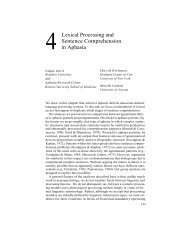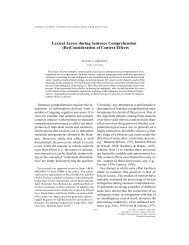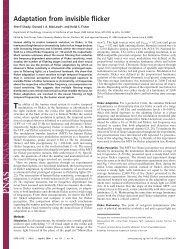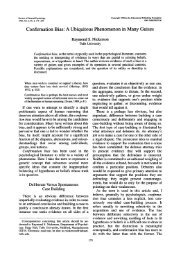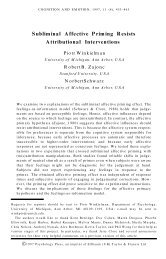Chapter 9 Moving verbs in agrammatic production
Chapter 9 Moving verbs in agrammatic production
Chapter 9 Moving verbs in agrammatic production
Create successful ePaper yourself
Turn your PDF publications into a flip-book with our unique Google optimized e-Paper software.
166 Grammatical disorders i n aphasia<br />
10-14% of the sentences, and there is no reason to believe that <strong>agrammatic</strong>s<br />
would prefer to use auxiliary constructions <strong>in</strong> 53% of the sentences,<br />
and then omit the auxiliary. True, <strong>agrammatic</strong>s do use forms that usually<br />
require an auxiliary verb, but only because the forms they use arc forms<br />
that do not carry tense, and therefore <strong>in</strong> normal syntax require an; auxiliary<br />
to carry the <strong>in</strong>flection.<br />
Verb omission: averbia or <strong>in</strong>flectional deficit<br />
Agrammatics frequently omit <strong>verbs</strong> <strong>in</strong> spontaneous speech and <strong>in</strong> picture<br />
description. This led researchers to claim that <strong>agrammatic</strong>s have an<br />
additional problem: averbia (see for example Z<strong>in</strong>geser and Berndt, 1990).<br />
That is - <strong>in</strong> addition to their other deficits, they also have a special<br />
problem <strong>in</strong> the lexicon that prevents them from retriev<strong>in</strong>g <strong>verbs</strong>.<br />
In the Bastiaanse and Van Zonneveld (1998) study, Dutch-speak<strong>in</strong>g<br />
<strong>agrammatic</strong>s had 'verb retrieval' deficits <strong>in</strong> second position only (where<br />
the verb has to be <strong>in</strong>flected) but not <strong>in</strong> sentence f<strong>in</strong>al position (where it<br />
appears <strong>in</strong> a low node). This f<strong>in</strong>d<strong>in</strong>g cannot be expla<strong>in</strong>ed by lexical<br />
retrieval deficit. It <strong>in</strong>dicates, rather, the strong relation between verb<br />
<strong>production</strong> and its sentential position, and raises the possibility that<br />
<strong>agrammatic</strong>s omit <strong>verbs</strong> not due to a lexical retrieval deficit, but due to<br />
their <strong>in</strong>ability to move them to the relevant functional categories <strong>in</strong> the<br />
syntactic tree and to <strong>in</strong>flect them correctly.<br />
Another corroboration for this claim comes from a tense treatment study:<br />
We<strong>in</strong>rich, Shelton, Cox and McCall (1997) report that their patients had<br />
severe tense-<strong>in</strong>flection deficit before treatment: they <strong>in</strong>flected only 5% and<br />
17%, 22% of their <strong>verbs</strong> correctly for tense. At that stage, their patient also<br />
had verb-retrieval deficit: they produced only 36%, 43% and 53% of the<br />
required <strong>verbs</strong>. After treatment of tense <strong>production</strong>, when their tense <strong>in</strong>flection<br />
has improved significantly (to 92, 64 and 73% correct), their verb<br />
retrieval ability had strik<strong>in</strong>gly doubled (to 89, 85 and 83%). This aga<strong>in</strong><br />
suggests the <strong>in</strong>volvement of <strong>in</strong>flection <strong>in</strong> verb <strong>production</strong>.<br />
This poses a new type of explanation for verb omission <strong>in</strong> terms of verb<br />
movement. When <strong>agrammatic</strong>s have to <strong>in</strong>flect a verb and move it to a<br />
pruned position, they sometimes prefer not to produce the verb at all. The<br />
deficit, then, is not a purely lexical deficit <strong>in</strong> the 'verb lexicon'. It is<br />
modulated, rather, by syntactic structure, and can be expla<strong>in</strong>ed with<strong>in</strong> the<br />
framework of pruned trees and the result<strong>in</strong>g verb movement deficit.<br />
Thus, verb omissions may result from the same deficit that causes verb<br />
<strong>in</strong>flection errors: a syntactic deficit.<br />
Inf<strong>in</strong>itives <strong>in</strong> Hebrew<br />
One of the important properties of the <strong>in</strong>f<strong>in</strong>itives that are used <strong>in</strong> <strong>agrammatic</strong><br />
<strong>production</strong> <strong>in</strong>stead of <strong>in</strong>flected <strong>verbs</strong> is that they arc bare <strong>in</strong>f<strong>in</strong>i-<br />
<strong>Mov<strong>in</strong>g</strong> <strong>verbs</strong> <strong>in</strong> <strong>agrammatic</strong> <strong>production</strong> 167<br />
Lives: namely, they do not conta<strong>in</strong> the 'to' morpheme. Agrammatics<br />
produce sentences of the form, but do not produce sentences like (13).<br />
12. Dori drive a Porsche<br />
Dori to drive a Porsche<br />
It is now clear why aphasics use <strong>verbs</strong> without the 'to' morpheme (see, for<br />
example, 'to' omissions <strong>in</strong> English and Dutch <strong>in</strong> Menn and Obler, 1990):<br />
'to' is a tense morpheme, and is located <strong>in</strong> Tense node which is located <strong>in</strong><br />
the pruned part of the tree. Whereas bare <strong>in</strong>f<strong>in</strong>itives are licensed <strong>in</strong> low<br />
nodes, their <strong>in</strong>flection 'to' is not.<br />
Consider the implications this has for the choice of replac<strong>in</strong>g forms <strong>in</strong> a<br />
language that does not have a bare verb, and where its <strong>in</strong>f<strong>in</strong>itive <strong>in</strong>cludes<br />
the 'to' as a bound <strong>in</strong>flection. In such a language, the <strong>in</strong>f<strong>in</strong>itive also has to<br />
move up to tense node to collect (or check) its <strong>in</strong>flection. In this case,<br />
<strong>in</strong>f<strong>in</strong>itives are expected not to be produced <strong>in</strong>stead of f<strong>in</strong>ite <strong>verbs</strong>.<br />
Fortunately we can test this <strong>in</strong> Hebrew, see<strong>in</strong>g as Hebrew is a language<br />
<strong>in</strong> which the <strong>in</strong>f<strong>in</strong>itive is not bare. The Hebrew <strong>in</strong>f<strong>in</strong>itive conta<strong>in</strong>s a<br />
morpheme which is the analogue of 'to' (the prefix 'le-'), and it is therefore<br />
parallel to the whole phrase 'to go' <strong>in</strong> English, and not only to the<br />
bare verb 'go'. Therefore, the <strong>in</strong>f<strong>in</strong>itive <strong>in</strong> Hebrew must raise high like an<br />
<strong>in</strong>flected verb, to check its <strong>in</strong>flection. Another demonstration for the<br />
difference between the Hebrew <strong>in</strong>f<strong>in</strong>itive and the English <strong>in</strong>f<strong>in</strong>itive is the<br />
fact that the Hebrew <strong>in</strong>f<strong>in</strong>itive does not appear as a complement of auxiliary<br />
<strong>verbs</strong>. Because it is <strong>in</strong>flected and occupies the Tense node, there is no<br />
place or need for an auxiliary. Furthermore, the movement pattern of the<br />
<strong>in</strong>f<strong>in</strong>itive <strong>in</strong> Hebrew is just the same as the movement of the f<strong>in</strong>ite verb:<br />
arguments from word order of ad<strong>verbs</strong> and <strong>in</strong>f<strong>in</strong>itives show that they<br />
raise to the same high node <strong>in</strong> the syntactic tree as f<strong>in</strong>ites (Shlonsky,<br />
1997).<br />
The prediction, then, is that <strong>in</strong> Hebrew, unlike <strong>in</strong> German and Dutch,<br />
for example, <strong>in</strong>f<strong>in</strong>itives will not be overused <strong>in</strong> <strong>agrammatic</strong> <strong>production</strong>.<br />
This prediction was tested <strong>in</strong> 11 Hebrew-speak<strong>in</strong>g <strong>agrammatic</strong> patients<br />
(Friedmann, 1998).<br />
Sentence repetition and verb completion <strong>in</strong> sentential context were<br />
used to assess <strong>in</strong>flection abilities and to f<strong>in</strong>d out whether <strong>agrammatic</strong><br />
aphasics use <strong>in</strong>f<strong>in</strong>itives <strong>in</strong>stead of f<strong>in</strong>ite <strong>verbs</strong> <strong>in</strong> Hebrew. Errors were<br />
analysed <strong>in</strong> order to determ<strong>in</strong>e whether <strong>agrammatic</strong>s substituted the<br />
<strong>in</strong>f<strong>in</strong>itive for f<strong>in</strong>ite <strong>verbs</strong>, or kept all verb <strong>in</strong>flection errors with<strong>in</strong> the f<strong>in</strong>ite<br />
paradigm.<br />
The results were clear-cut: substitution errors were almost always<br />
with<strong>in</strong> the f<strong>in</strong>ite paradigm (or possibly <strong>in</strong>cluded substitution of the<br />
participle which is identical to the present tense). Errors were substitution<br />
of one tense for another, but almost never substitution of <strong>in</strong>f<strong>in</strong>itival form<br />
for the f<strong>in</strong>ite. 9 Aga<strong>in</strong>, each <strong>in</strong>dividual patient showed the same pattern of



